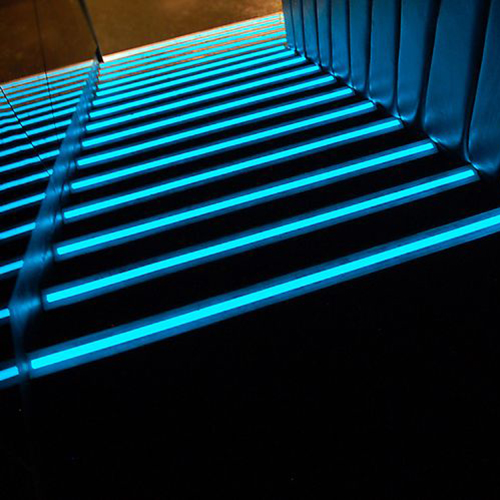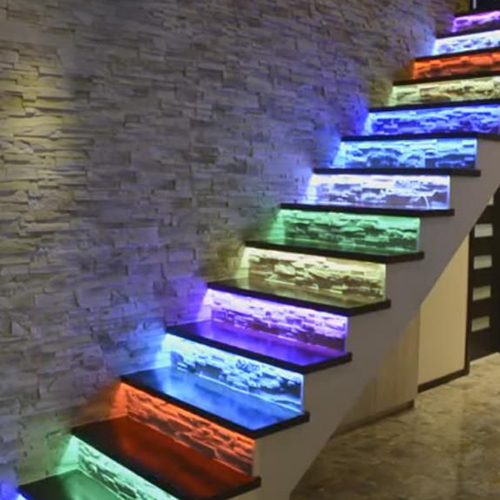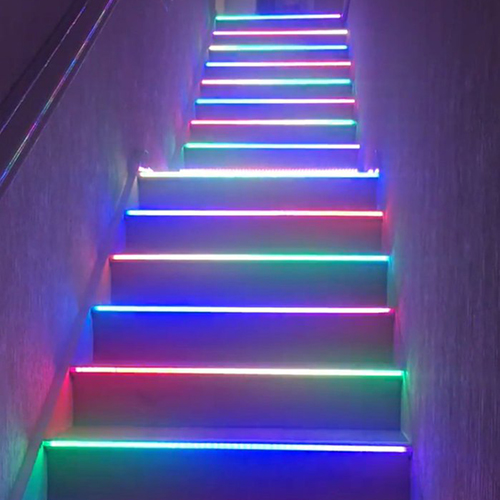LED lights are widely used in modern stair lighting solutions because of their energy-saving features. Among them, the application of LED light strips is worth a deep understanding. In addition to the traditional white staircase lighting, LED strips allow a wider range of lighting colors to suit the needs of more users. There are many solutions for stairway lighting, which one is best for you? Let’s take a look together.
| Contents 1. Pros and Cons of Investing in Stair Lights 2. Why Choose LED Light Strips for Stair Lighting? 3. What Light Color is Suitable for My Stairs? 4. How do You Put Lights on Stairs? 4.1 Stair Lights Indoor 4.2 Outdoor Stair Lights 4.3 Motion Sensor Stair Lights 5. FAQs About Stair Lights 6. End Words |
Pros and Cons of Investing in Stair Lights
Before elaborating on the relevant aspects of stair lights, let’s take a look at the pros and cons of investing in them. The most significant role of stairway lights is to provide people with sufficient light when going up and down the stairs, and avoid the risks of stepping in the air. A good stair light design can add aesthetics to your home or outdoor landscape and accentuate the stepping function of the stairs.
There are many light fixtures available for stair lights, and which one to choose depends on your stair and your preferences. There is no doubt that investing in stairway lights costs money, ranging from less to more. What’s more is that once the stair lighting is installed, you can enjoy it for a long time without frequent replacement, and it is easy to replace.
Why Choose LED Light Strips for Stair Lighting?
A well-recognized point about LED lights is energy saving. LED stair lights allow using less electricity to drive light, saving electricity bills. In addition, compared to traditional lighting, LED strip lights generate less heat and have a longer service life of 50,000 hours.
The LED light strips can be directly installed on the stairs without complicated operation. You can even add aluminum profiles to the light strip to cover the LED spot, uniform light, dissipate heat, prolong LED’s life, prevent the strip light from falling off, and create the effect of invisible lamps. Linear LED strips illuminate staircase areas more evenly than LED recessed lights and wall lights, which are better for auxiliary lighting.
LED light strips display different colors by using different chips, with a variety of solid colors and changing colors, which are not only suitable for users who pursue simplicity and fashion, but also meet the mood and atmosphere needs of other users.
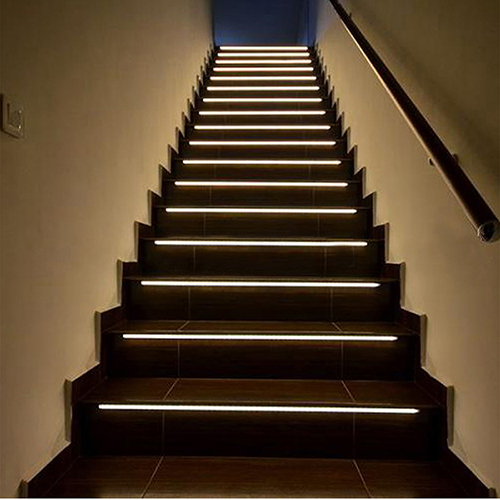
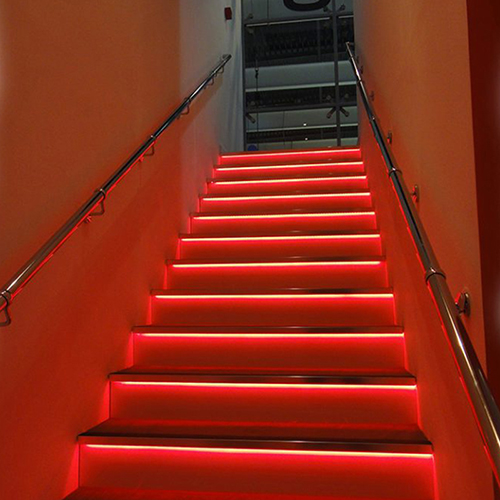
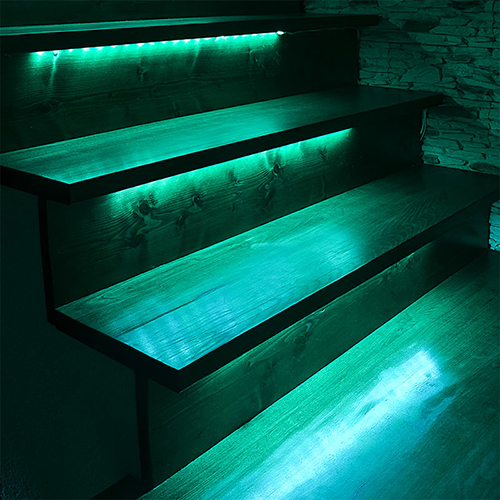
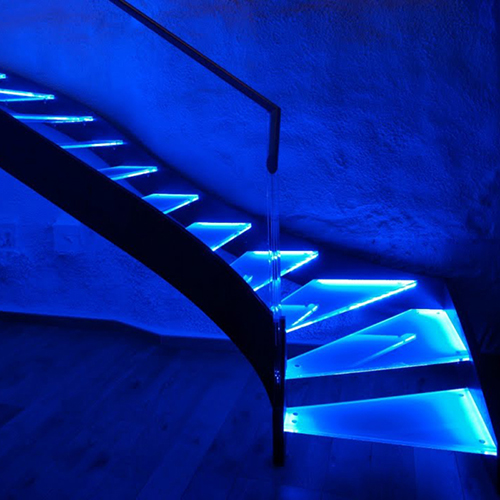
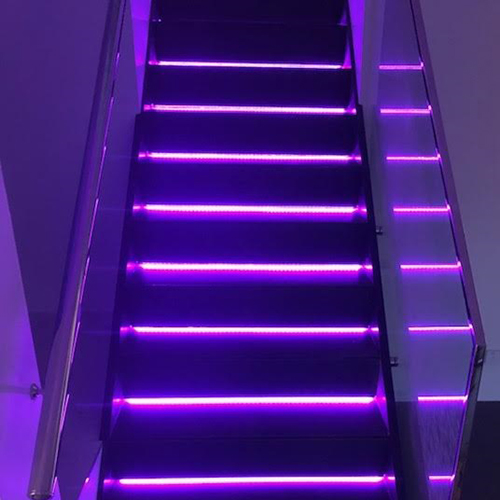
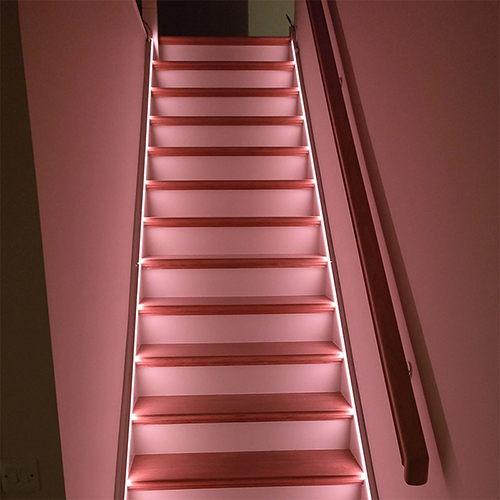
What Light Color Is Suitable for My Stairs?
White color is the most basic and universally applicable stairway lighting color. If you choose white light, you need to know what color temperature your stairs are suitable for.
Warm white usually feels comfortable and relaxed, with a soft yellow tone. The wood-colored stairs have retro characteristics, the 2800K-3200K warm white light can better reflect its texture. If your home style is mainly white, it is recommended to use 4000K-4500K natural white light, which is bright and not dazzling. 6000K-6500K cool white light has higher brightness, so it will make people concentrate.
Colorful staircase lighting adds entertainment properties to the stairs and is suitable for users with children at home or to attract the attention of customers in public places.
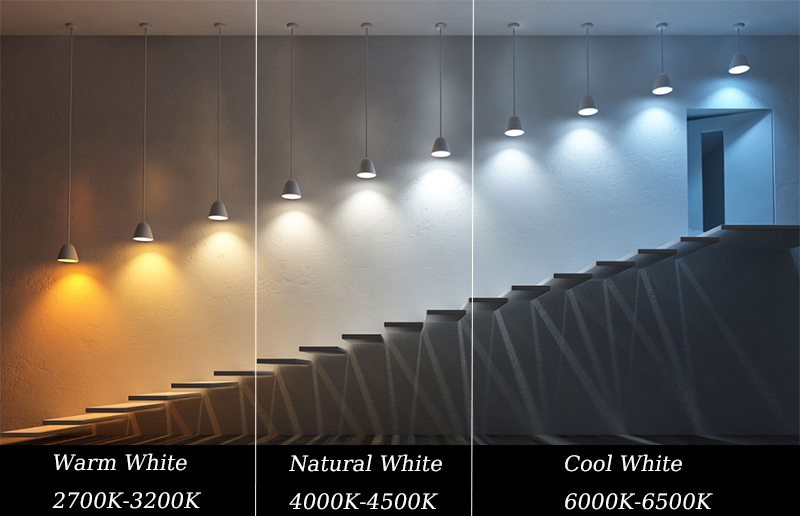
How Do You Put Lights on Stairs?
The lighting arrangement of the stairs is a knowledge that needs to match your home style. The most basic requirement is that there is sufficient light to avoid shadows in the line of sight caused by too dark light. On the other hand, in addition to the practical basic lighting function, stair lighting also undertakes the transitional role of connecting different space styles up and down the stairs. Stairs and lamps complement each other, giving people a comfortable visual experience.
Stair Lights Indoor
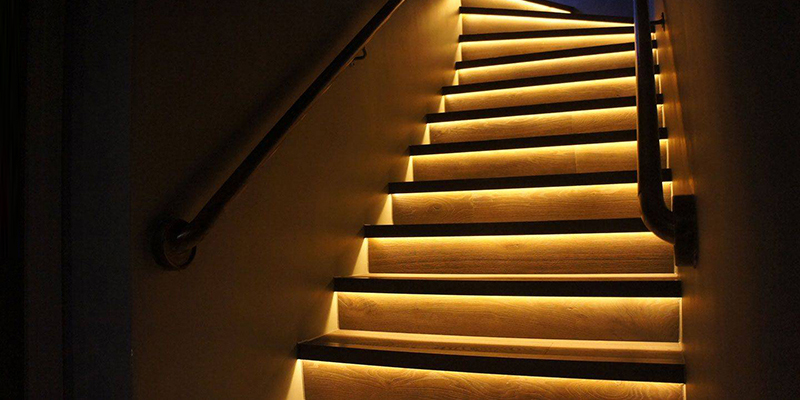
1. Hide LED strip lights under stair treads for soft and linear light. The LED light strip comes with a 3M adhesive tape, and tear off to paste. You can choose to install LED strips on every step or just select a few steps, it’s all up to your preference. If the steps of the stairs do not have an extended structure, you can add a stone board or wooden board to form the conditions for installing the light strip.
Corner LED profiles are also particularly suitable for under-stair lighting. A 1m/3.28ft led strip diffuser is held in place using two mounting clips, so you don’t have to worry about it falling off. In addition, the LED channel used aluminum alloy as the production material, which is small in size and low profile, not taking up space.
Lighting on stair steps is also generally used in public places, shopping malls, KTVs, etc. The LED light strips are embedded in the steps and covered with a frosted diffuser, which transmits light but does not glare.
The strip light wires on each step need to be connected to the controller and power supply. If the total length of the led light strips used exceeds 5 meters, do not connect the led strips in series, as the voltage drop will cause the light color and brightness to change. The wires can be hidden on the side of the stairs or under the stairs by cable trunking.
TIPS: Consider the light trough before decoration. Use COB LED strips or aluminum strip lights to create linear lighting. If the steps are paved with very bright stones or tiles, the LED lights should not be illuminated downwards to avoid specular reflection. There shouldn’t be too much room for the pedals to stick out, it’s easy to stumble. Take care to hide wiring lines.
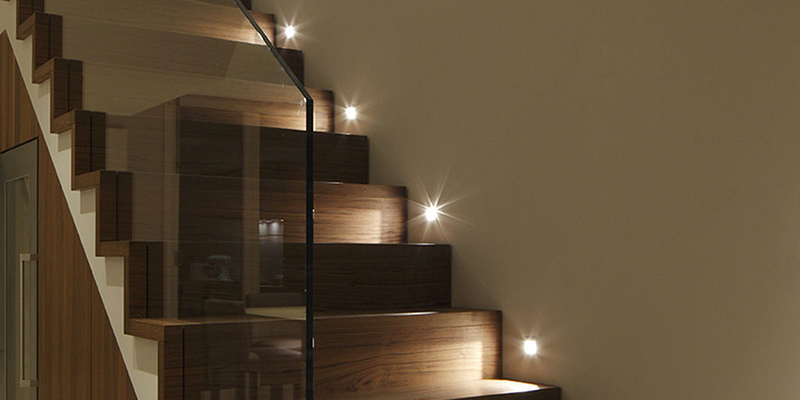
2. Install recessed LED lights on side of the stairs as accent lighting to add ambiance to your home lighting. LED recessed lighting adds light to the staircase from the side. When installing, pay attention to the installation height and spacing of the lights. At the same time, you need to open holes on the side of the stairs to accommodate the recessed LED lights. Of course, you can also choose point light type surface-mounted LED stair lights.
The lighting along the stairs is generally suitable for use when the stairs are spacious, but the construction will be a little troublesome. Compared with the direct paste installation of led light strips, this method requires you to have better practical ability and experience to complete it perfectly. However, this contour light does look more layered.
TIPS: The power of the LED recessed lights should not be too high, usually 1-3W. You can choose the recessed led lights with an induction device. Take care to hide wiring lines. If you don’t want to wire, you can choose a rechargeable motion sensor light that can be attached to the stair wall, relatively low cost, simple installation, and high practicability.
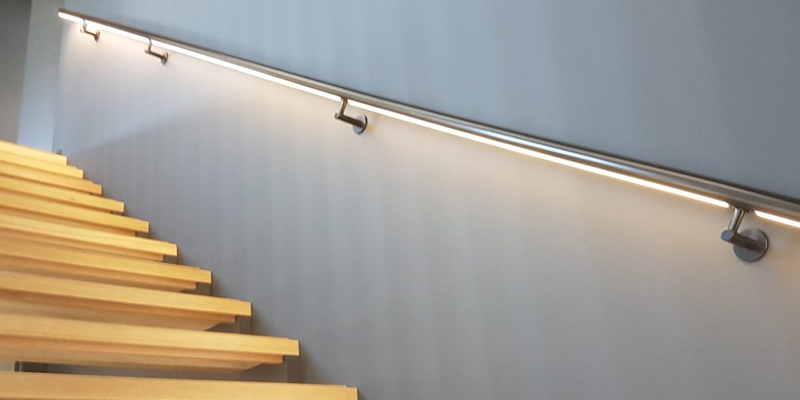
3. If your stairs with handrails, adding LED lighting under the handrails is also a good idea. There are several ways to create handrail lighting. One is to directly paste the led light strip under the rail. The second is to use surface-mounted aluminum channels to soften the LED light. The third is to slot the handrail and hide the led strip or aluminum strip in the slot.
If there is no handrail, you can also make a handrail on the wall on both sides of the stairway or on one side, so that the lighting area is larger, but the lighting position of the handrail stair lights should be below the waist, and the LED light should not be too bright.
This kind of stair lighting is not suitable for public areas that require high illumination. If the stairs are very wide, other auxiliary lighting is required to improve the safety factor of stair illumination.
TIPS: Choose low-power led strip lights. Use a long led strip or strips that connect seamlessly to avoid dark areas. Pay attention to hidden strip light wires during installation.
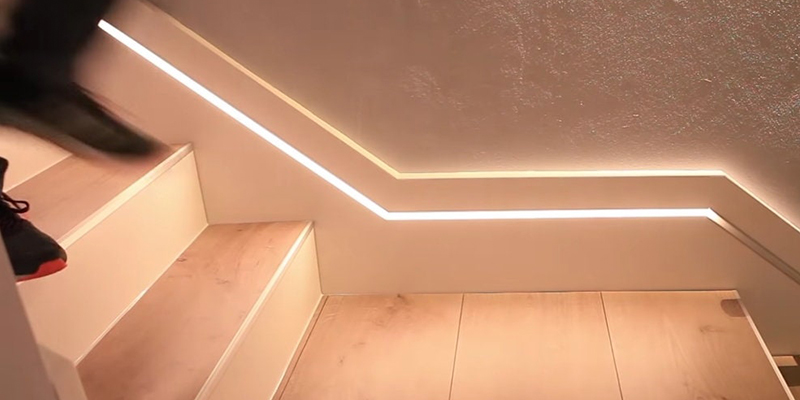
4. Linear lighting on the side of the stairs can improve illumination. It is also suitable for creating a dynamic sense of light flowing with your pace. The flowing water effect of stairway lighting is achieved by installing addressable led strips. LED light strips can also be installed in the gap between the stairs and the wall to brighten the wall, providing facade lighting and indirect lighting.
This method is easier to hide the wires, using one or two long led light strips, no complicated wires. Even in the case of supply power at both ends of the strip, the light strip wire that is far from the power source can pass through the aluminum channel groove or cable trunking and return back. And if the power wire is too long, there will also be a voltage drop, so you need to choose a suitable wire gauge. The larger the wire size, the more it can withstand and the lower the voltage drop.
TIPS: Keep LED lights continuous to avoid dark areas. Take care to hide wiring lines.
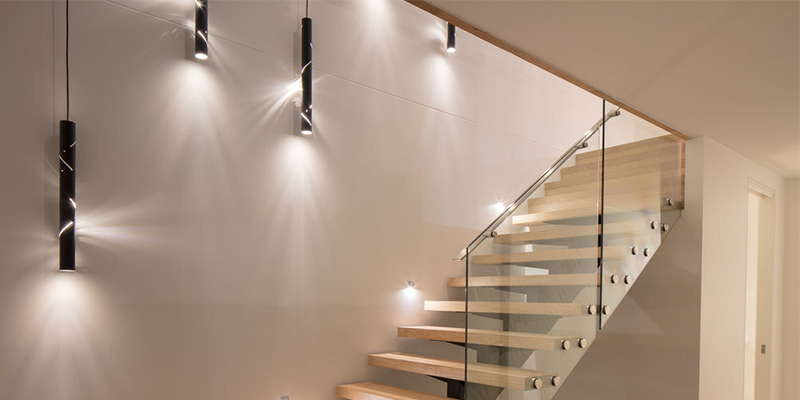
5. Creating one or a series of stair wall lighting is a great effect too, especially for stairwells with paintings or other decorations. It can be combined with step lights to create the perfect layering scheme for your staircase lighting.
Installing LED wall lights with a sense of design on the stairwell walls or using simple wall lights to wall washer and highlight the wall texture is a common design method for this kind of stair lighting.
For multi-story staircase design, place a large light fixture at the center of the staircase, such as a ceiling stair light, to reduce complex installation and reduce high costs.
TIPS: Since it is indirect facade lighting, the power and brightness of the stair lights should not be too high, and direct light is prone to dizziness.
Outdoor Stair Lights
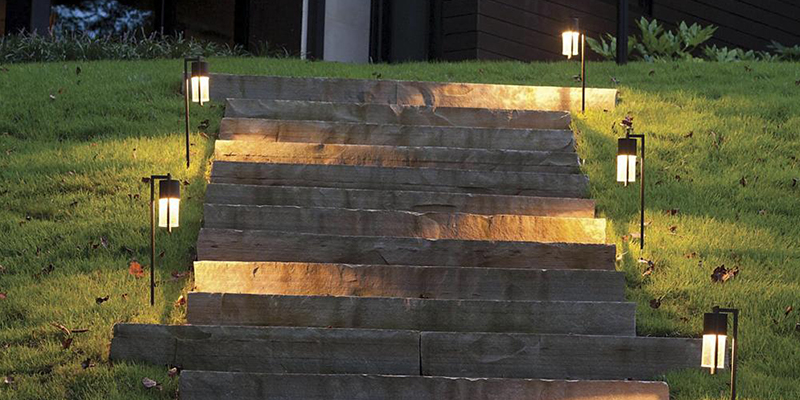
The most important thing for outdoor stair lights is to consider weatherability and waterproofing. Installing linear or point LED lights in outdoor stair areas is a minimalist and practical approach. LED lights highlight each step, create light paths, provide safety lighting for passersby and set the mood for party events.
1. How do you light an outdoor staircase? Outdoor Stair Lighting Ideas: 1) Hide stair lights under deck steps to get soft linear lighting or point lighting. 2)Recessed stairway lights in the steps. 3) Add linear lighting or point lighting to the sides of the outdoor stairs. 4) Place path lights around garden stairs. 5) Add LED strip lighting under deck railings. Click here to learn more about our motion sensor outdoor stair step lights kit. If you need waterproof led strip lights, please click here.
2. How do you light outdoor stairs at night? Use solar motion sensor lights as light sources for outdoor stair lighting. It uses solar panels to charge rechargeable batteries. Output power at night through intelligent infrared and light-controlled switches. When someone is close to the infrared, it will automatically detect and automatically light up the stairs. Our outdoor wall solar motion sensor light: link 1, link 2, link 3, link 4.
There’s not just one set way to stair lighting, use your ingenuity to DIY.
Motion Sensor Stair Lights
Intelligent stair lights use motion sensor light technology. When you walk into the sensing range, the staircase lighting will automatically turn on. It is realized by two motion sensors on the controller, one is located at the upper end of the stairs and the other is located at the lower end of the stairs.
This method is very convenient for you to go up and down the stairs, no need to manually turn on or off the light switch, and as you move away from the stairwell, the stair lighting will automatically turn off, saving lighting costs. The inductive stair controller allows you to adjust the brightness, speed, and lighting mode of the step lights. Click here to know about our LED motion sensor stair lights kit.
For low-power low-voltage LED strip lights used in stairway lighting, adding a motion sensor switch or PIR sensor switch can help you use it better. These mini sensor switches are for 12V or 24V single color led strip lights, easy to hide in the led channel slot. Click here to know more.
FAQs About Stair Lights
What lights to use for stairs? You can use led strip lights, led recessed lights, led wall lights, motion sensor lights, solar lights, and stair ceiling lights for indoor and outdoor stairs.
How do you illuminate a stairwell? Lighting the stairs starts with considering how much light you need. Recessed lighting and wall lighting are optional for stair auxiliary lighting. If you want to completely illuminate the entire staircase, it is best to choose led light strips to make step lighting.
How do you cut LED strips for stairs? LED light strips have cutting lines, which can be cut and connected arbitrarily. Click this blog to learn more.
How do you install LED lights on stairs? Stair light installation is simple and difficult. This blog talks about how to connect our Motion Sensor Stair Lights. If wiring problems are bothering you, it’s best to consult a local electrician.
Are motion sensor lights worth it? There are many types of motion sensor light fixtures, they will not raise electric bills, are easy to install, and do not need a light switch. The motion sensor stair lights turn on and off automatically.
End Words
To sum up, using LED lights to illuminate stairs is nothing more than a few principles. What complicates is how these principles fit into your actual situation. If you are going to decorate your stairwell with LED lighting, don’t ignore any stair lighting method, consider these methods comprehensively and choose the best lighting method for your indoor and outdoor stairs.
